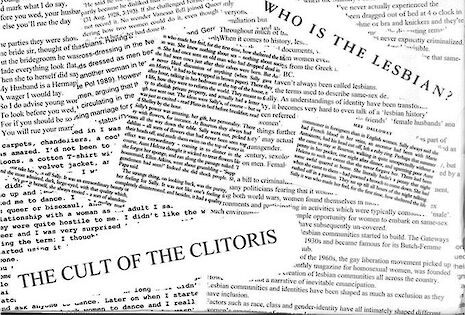Review: The Cambridge Companion to Lesbianism
Polly Evans and Emma Snell found The Cambridge Companion to Lesbianism a “fascinating piece of theatre”

The Cambridge Companion to Lesbianism is a fascinating piece of theatre. From a historical perspective, the content alone is bound to pique your interest, and the simple yet poignant delivery aptly brings to life this selection of historical and literary sources.
“Admirable gracefulness”
The performance unpretentiously guided the audience through a chronological history of lesbian narratives and historical accounts. The creators of the piece describe it as "a kind of collage" –a fitting description for something that so seamlessly fuses the artistic with the informative. Accompanying the performance was a zine which included collages of excerpts read with images. The cast, which consisted solely of non-binary people and women who identify as LGBTQ, gave their interpretations of various excerpts from love letters, novels and historical accounts, all of which centre around the queer experience. The Corpus Playroom’s unique shape enabled the actors to face the audience from multiple angles; this use of physical space seemed to appropriately mirror the presentation of a multiplicity of voices, once lost in history, finally being heard. Like any successful assemblage, the individual segments are thought-provoking in their own right, yet by placing them in a dialogue with each other the directors manage to convey the breadth and variety of experiences that comprise the lesbian narrative with an admirable gracefulness.
“Her suggestive intonation injected the case with humour and warmth”
Some of the accounts were subtler than others in their treatment of a lesbian narrative, particularly those from the early 20th century, when discussions of same-sex love often couldn’t be explicit and relied on allusion; an interesting dynamic emerged from the paradox of a public reading of private letters – and ones that seem at once open and honest, and yet simultaneously guarded and weary of censorship. This sense of incongruity was present throughout the production, where the pieces would oscillate between effusive proclamations of love and rage at an establishment that aimed to restrict same-sex love between individuals. Although the segments took the form of monologues, the directors often placed the individuals in an indirect dialogue. For example, one letter writer and recipient were placed side-by-side, responding to each other via silent facial expression, establishing a sense of the painful dichotomy of emotional proximity and physical distance between two lovers. A stand-out scene involved Maud Allen (Isabella Leandersson) sitting on a chair reading excerpts of a defamatory newspaper article about her titled The Cult of the Clitoris; her glances to the audience as she reads alongside her suggestive intonation, inject the case with humour and warmth, bringing Allen to life as a humorous and engaging individual rather than just a victim of a past court case.
At points the actors spoke too quickly, or struggled with the admittedly difficult task of dramatically presenting pieces that were clearly not written to be performed, yet O'Flynn and Firmin’s creative presentation meant that such difficulties where navigated as smoothly as possible, a real credit to them both considering the enormity of the challenge they have set themselves. In the short space of 45 minutes, the cast and crew managed to give a rich and varied history of the queer experience from women throughout the past two centuries. We left the Corpus Playroom not only feeling like we’d learnt a lot, but also that we’d also been give the opportunity to engage with the emotions and inner feelings of these women – their happiness in love, their heartbreaks, and their political frustrations
 News / Caius mourns its tree-mendous loss23 December 2025
News / Caius mourns its tree-mendous loss23 December 2025 News / Clare Hall spent over £500k opposing busway 24 December 2025
News / Clare Hall spent over £500k opposing busway 24 December 2025 Comment / The ‘class’ of Cambridge24 December 2025
Comment / The ‘class’ of Cambridge24 December 2025 Interviews / Politics, your own way: Tilly Middlehurst on speaking out21 December 2025
Interviews / Politics, your own way: Tilly Middlehurst on speaking out21 December 2025 Comment / Yes, I’m brown – but I have more important things to say22 December 2025
Comment / Yes, I’m brown – but I have more important things to say22 December 2025








